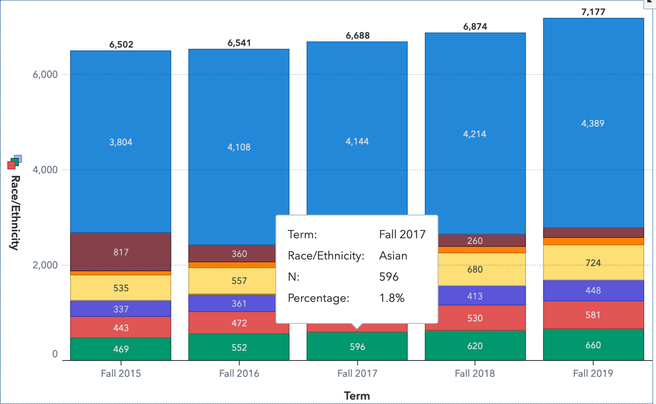- Home
- /
- SAS Viya
- /
- Visual Analytics
- /
- Re: Calculating frequency percentage by category in Visual Analytics 8...
- RSS Feed
- Mark Topic as New
- Mark Topic as Read
- Float this Topic for Current User
- Bookmark
- Subscribe
- Mute
- Printer Friendly Page
- Mark as New
- Bookmark
- Subscribe
- Mute
- RSS Feed
- Permalink
- Report Inappropriate Content
Hi all,
I am brand new to SAS Visual Analytics, so forgive me if there is an obvious answer to this question that I have missed (but I have searched this forum and have not found an answer). I am creating a stacked bar chart displaying the race/ethnicity (group) of a population over a 5 year period (category includes five values: 2015, 2016, 2017, 2018, 2019). I am displaying the frequency as my measure, but I would like the end user to be able to also see the frequency percent as a data tip. However, when I select frequency percent as a data tip value, the percentage is being calculated using the entire dataset's number of observations (all five years) as the denominator. What I want is to display the frequency percent using each distinct category's observations (i.e., each year's observations) as the denominator.
Someone posted a similar question to this forum and the response was to select "Normalize groups to 100%" in the options. While this does show the correct frequency percent (by year), it's not an ideal solution, because I lose the ability to visualize the magnitude of raw growth over time. I am attaching a screenshot of the problem below. For example, I want the frequency percent in the data tip to calculate the percentage of the Asian population in the Fall 2017 term as 596/6,688=8.9%, but the frequency percent is currently using the entire number of observations in the dataset (6,502+6,541+6,688+6,874+7,177) as the denominator.
Appreciate any help!
Thank you,
John
Accepted Solutions
- Mark as New
- Bookmark
- Subscribe
- Mute
- RSS Feed
- Permalink
- Report Inappropriate Content
Hello @JohnDooris
Welcome to our community! Yes, this is easily doable with the AggregateTable operator which you use to fix the aggregation to Term level.
For more information about AggregateTable: https://communities.sas.com/t5/SAS-Communities-Library/SAS-Visual-Analytics-Advanced-Calculations-pa...
Here's the New Calculated Item view:
Here's the code:
Sum [_ByGroup_] ('Population'n) / AggregateTable(_Sum_, Table(
_Sum_, Fixed('Term'n), 'Population'n))
And here's how it looks:
I hope this helps 😃
Best regards,
Petri
- Mark as New
- Bookmark
- Subscribe
- Mute
- RSS Feed
- Permalink
- Report Inappropriate Content
Hello @JohnDooris
Welcome to our community! Yes, this is easily doable with the AggregateTable operator which you use to fix the aggregation to Term level.
For more information about AggregateTable: https://communities.sas.com/t5/SAS-Communities-Library/SAS-Visual-Analytics-Advanced-Calculations-pa...
Here's the New Calculated Item view:
Here's the code:
Sum [_ByGroup_] ('Population'n) / AggregateTable(_Sum_, Table(
_Sum_, Fixed('Term'n), 'Population'n))
And here's how it looks:
I hope this helps 😃
Best regards,
Petri
- Mark as New
- Bookmark
- Subscribe
- Mute
- RSS Feed
- Permalink
- Report Inappropriate Content
Thank you @PetriRoine !
April 27 – 30 | Gaylord Texan | Grapevine, Texas
Registration is open
Walk in ready to learn. Walk out ready to deliver. This is the data and AI conference you can't afford to miss.
Register now and lock in 2025 pricing—just $495!
See how to use one filter for multiple data sources by mapping your data from SAS’ Alexandria McCall.
Find more tutorials on the SAS Users YouTube channel.





